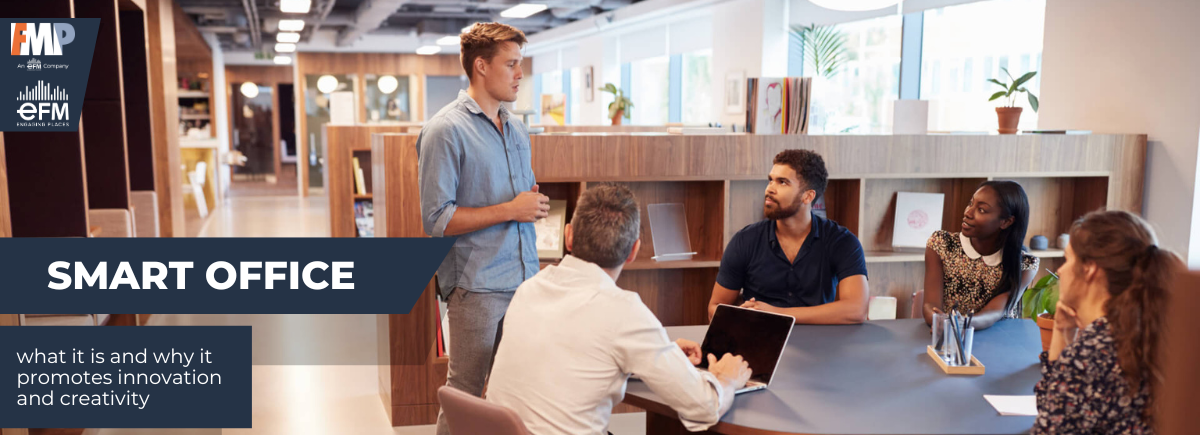
Smart Office: what it is and how it fosters innovation and creativity
On Mar 21, 2024
The Smart Office embodies the essence of new ways of working, which now revolve around the balance and synergy between physical and virtual work experiences. It’s not the office of yesterday, with its open spaces, fixed workstations, and meeting rooms, but rather a modern and technological adaptation designed to accommodate a profoundly different, hybrid and widespread working model (from Headquarters to Hub Quarter).
Companies are undergoing a profound transformation of the work paradigm, a cultural, organizational, and process transformation before it’s even technological. Working is now finally an activity, an experience; it’s no longer just a physical place we go to every day. Given external circumstances, today people can work from home, go to the office, or to a coworking space, in any city location that best supports the overall work experience and the specific task at hand. It’s clear that the traditional office must change and, in line with a now very fashionable trend, become smart.
Transforming the Old Office into a Smart Office
In light of these developments, companies have a unique chance to capitalize on significant opportunities: they can redesign their environments and achieve immediate savings (if the office is widespread, the physical space occupancy is naturally lower), but above all, create engaging places aligned with a modern and connected work experience. This calls for a redesign of spaces according to the principles of Activity Based Working, including the use of advanced sensors and Artificial Intelligence for service optimization, asset booking systems for booking workstations, meeting rooms, social areas, parking spaces, and coworking spaces, and experience assistants adopting a holistic approach to help people have the best possible work experience in the era of distributed offices. In its physical manifestation, the Smart Office is the result of architectural, design, furnishing, and technological choices aimed at making it engaging, fostering collaboration, and best manifesting the company’s culture and values.
Smart Office as a Source of Creativity and Innovation
The Smart Office can be an extraordinary source of creativity: some areas, previously occupied by company employees, can be shared with other organizations, turned into open spaces for external professionals, thus fostering positive interactions, serendipitous encounters, appreciation for diverse ideas and perspectives, and igniting the creativity that drives innovation. Creativity can also be encouraged in other ways: for example, by designing shared spaces that facilitate cross-departmental interactions, having well-equipped rooms tailored for brainstorming sessions, and ensuring dedicated areas for focused work.
The Virtual Dimension of the Smart Office and the Value of Community
The Smart Office, in its distributed office concept, therefore has both a physical and a virtual component. Even its virtual dimension offers extraordinary opportunities for organizations: unlike in the past, today it is possible to bring together the entire workforce within a single virtual space, regardless of division, location, country, point of sale or facility type. The digital workplace encompasses the entire company, extending its reach to satellite employees who have long felt disconnected from the organization’s culture and values. The transformation of the work paradigm and the introduction of a Smart Office present an extraordinary opportunity to break down silos entrenched for years, review aspects of corporate culture unsuitable for agile working, create new communication dynamics, and break traditional top-down logic culture. The goal is to introduce a model that encourages collaboration and constant dialogue, as well as participation and casual feedback, because creativity and innovation depend on them.
To achieve this result, however, enabling platforms is not enough; what’s imperative is a comprehensive organizational transformation and significant investment by the organization in its community. The latter, however, faces the risk of being impacted by the reduced physical interactions inherent in the new work paradigm, potentially resulting in disengagement. A company’s effective response lies in the creation of virtual spaces, structured event programming, and fostering dialogue and knowledge exchange. These measures serve to align the community more closely with the company’s market positioning and values.
Embracing the Future: The Transformative Power of the Smart Office
In essence, the Smart Office embodies a transformative approach to work, seamlessly integrating physical and virtual realms to cultivate an environment where innovation and creativity thrive, ultimately shaping the future of work.